2020 Kawasaki Teryx KRX 1000 Driving Impression
Also posted to:
Kawasaki’s First Sport Side X Side
We have our first 2020 Kawasaki Teryx KRX 1000 driving impression. We spent about three hours putting the Teryx KRX 1000 through its paces at the Kawasaki dealer introduction in Palm Springs, California.
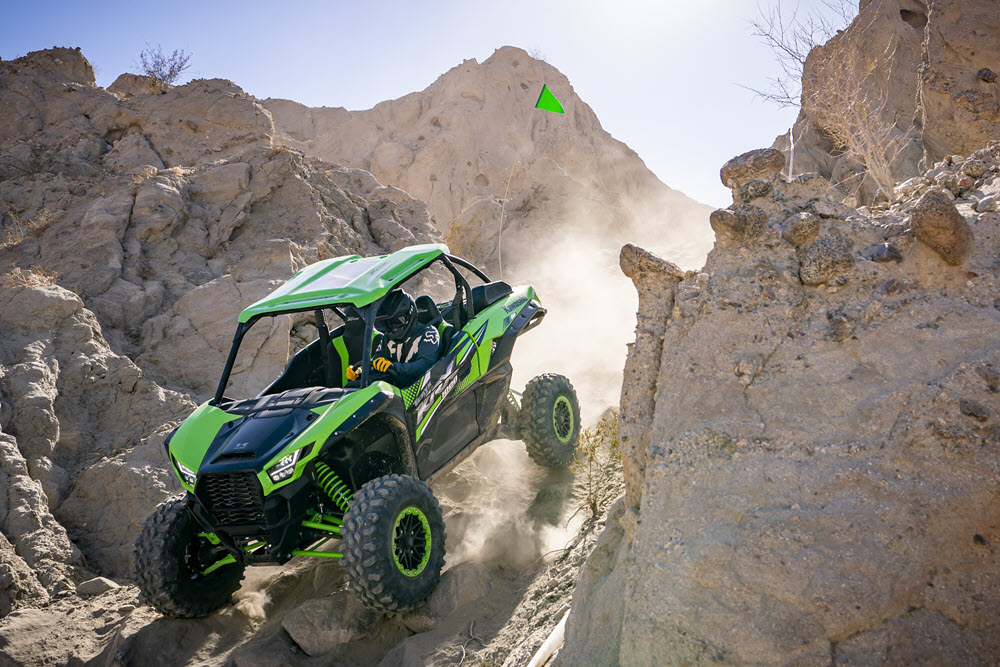
The new Kawasaki Teryx KRX 1000 can be added to the list of high-performance sport UTVs to choose from.
Photos Courtesy of Octipi Media
We have our first 2020 Kawasaki Teryx KRX 1000 driving impression below but first a quick history lesson. Kawasaki entered the Utility UTV market way back in 1988 with the introduction of the MULE, and the line continues to be a popular choice for farm and utility use. In 2008, Kawasaki introduced the first Teryx 750 that was aimed at more recreational use than the Mule, and, although the Teryx has undergone several updates, it has not been a true option for the pure sport UTV enthusiast. For 2020, that changes with the introduction of the Teryx KRX 1000. The KRX 1000 is a true sport UTV that can be considered among the other high-performance options from Polaris, Can-Am, Yamaha and Honda.
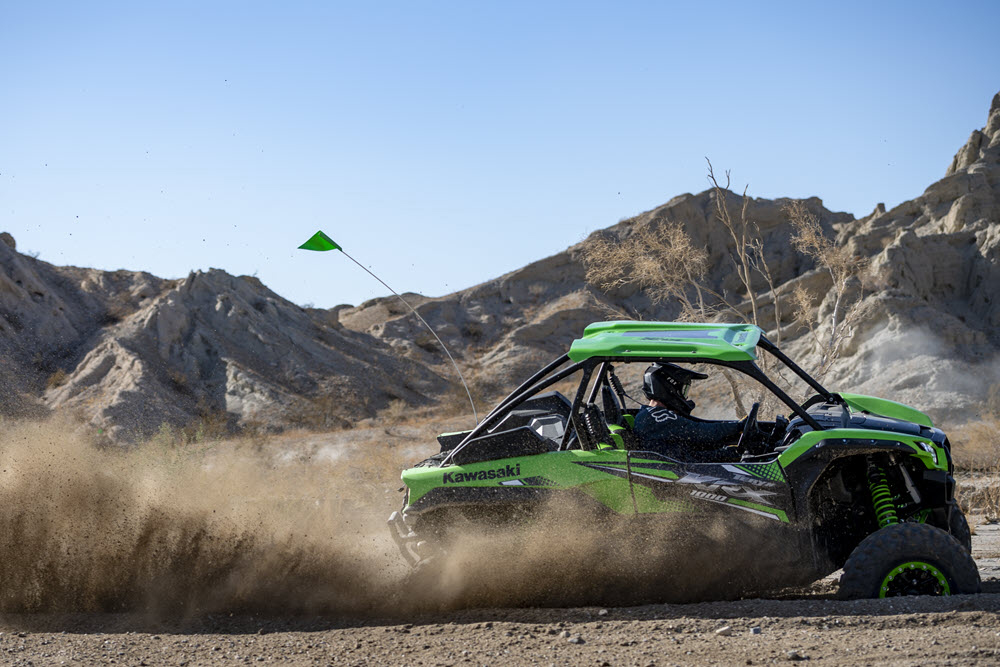
The Teryx KRX 1000 is very predictable and easy to drive aggressively. It does however have a bit of body roll in corners.
Kawasaki Teryx KRX 1000 Specs
The KRX 1000 features a naturally aspirated 999cc DOHC, water-cooled, parallel-twin engine with a CVT transmission that includes a centrifugal clutch and belt drive. It includes dual power modes with a dashboard switch. You can switch between two-wheel and four-wheel drive on the fly with another switch, which also includes a front differential-lock option. All of these modes are displayed on the dash along with a bar-style tachometer, digital speedometer, fuel gauge, gear indicator (L, H, N, R), power mode, driving mode (2WD/4WD/4WD+DIFF Lock), clock, odometer, tripmeter, hour meter, water temp, battery gauge, oil warning lamp, water temp, and CVT Belt temperature.
The KRX 1000 has a 98.8-inch wheelbase and 68.1-inch width. The double wishbone front suspension provides nearly 19 inches of travel. The rear end uses a 4-link trailing-arm suspension system with 21 inches of travel. Both ends use FOX 2.5 Podium LSC shocks with piggyback reservoirs, preload adjustment and 24-position compression damping.
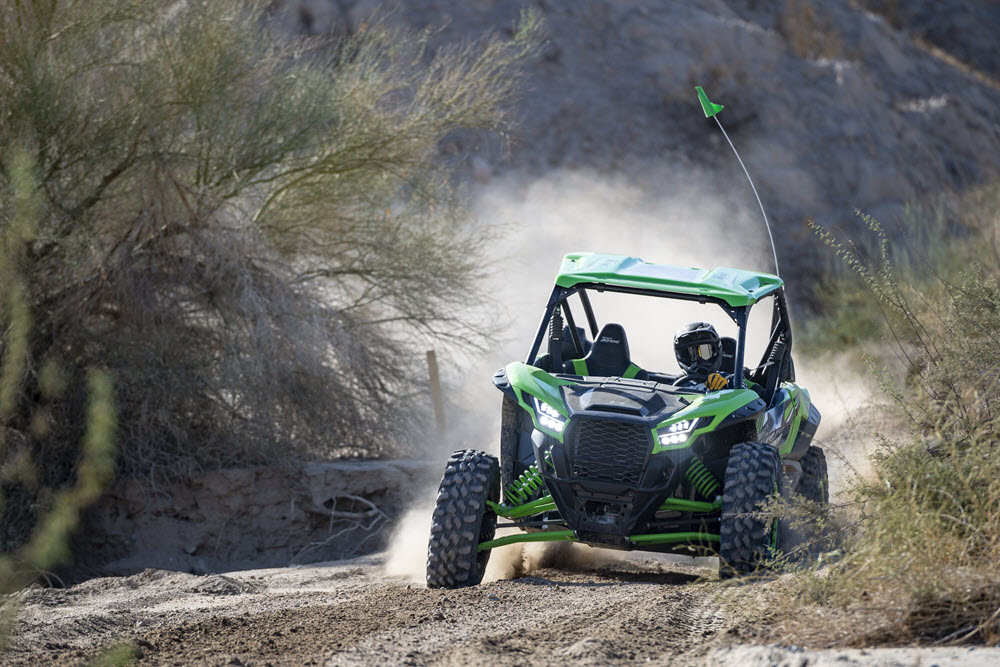
Kawasaki created an excellent test course in the desert near Palm Springs, California to provide the media and dealers an opportunity to drive the KRX 1000. It included some rocky hills and fast sand washes like this to get a feel for its high-speed capabilities.
Kudos to Kawasaki on the styling of the KRX 1000 as nearly everybody in attendance at the launch agreed that it looks great. The integrated roll cage has a nice shape and is attached to the frame in eight locations (Kawasaki calls this the 8-point Rollover Protective Structure, ROPS). Kawasaki claims that the KRX 1000 is designed to be extremely durable with a heavy-duty frame and components that will withstand a lot of abuse. The entire underside of the KRX is covered with a combination of plastic and steel skid plates, with 80% of that being steel. This likely contributes to the relatively heavy claimed weight of 1896 pounds. Based on a visual inspection of the parts and accessories, it certainly looks stout.
The Teryx KRX 1000 comes with 31-inch-tall Maxxis Carnivore tires and 15-inch beadlock wheels. The front brakes are dual-piston hydraulic discs and the rear uses single-piston calipers. To help reduce the need for using those brakes, the KRX 1000 has built-in engine braking that will hold the vehicle back on downhills. Also for driver comfort the KRX 1000 includes speed-sensitive Electric Power Steering (EPS).
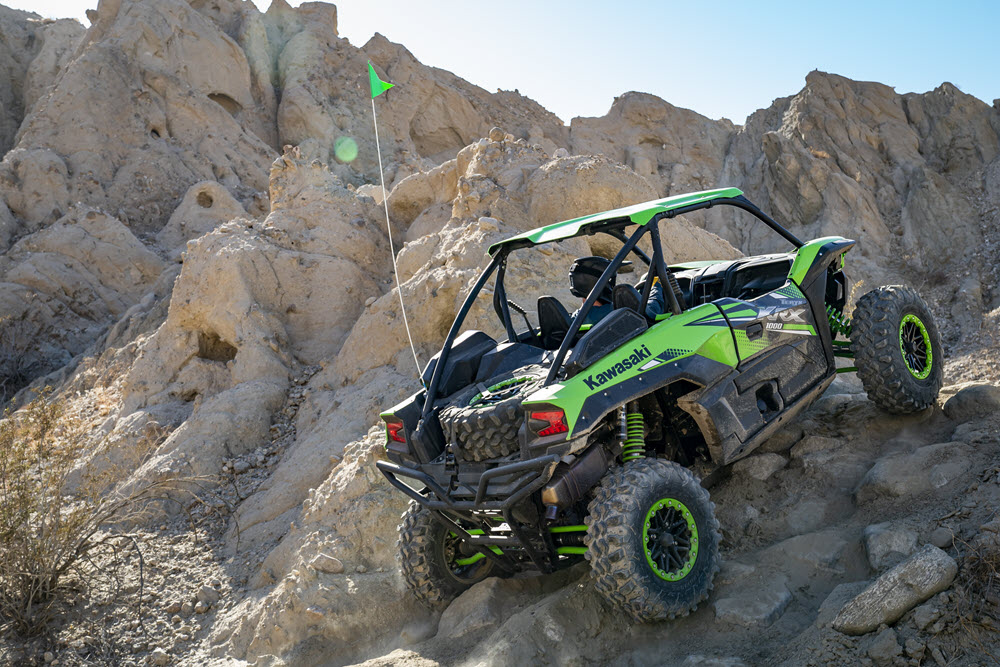
Rock crawling is where the new Teryx seems to really shine. The engine and clutch are very easy to manipulate in technical terrain.
2020 Kawasaki Teryx KRX 1000 Driving Impression
We got to spend three hours driving the Teryx KRX 1000 at the Kawasaki dealer introduction in Palm Springs, California. They build two courses in the desert that included most of the obstacles you would find on typical trail rides. The only thing missing were some rough whoop sections to really feel the suspension performance at higher speeds.
You step into the vehicle via full-coverage doors and sit into reasonably comfortable seats with an automotive-style three-point harness on both sides. One nice feature is that both the driver and passenger seats have six inches of adjustability. It feels comfortable for a wide range of heights. It has a pretty standard tilt steering wheel and the dash noted above is directly in front of the wheel. Even though there are only two seats in the KRX 1000, there are five cupholders. Plus, there is a glove box and separate center storage high on the dash. The passenger side includes an adjustable grab handle.
Both of the loops started with a drag-strip-type stretch to allow us to feel the acceleration and stopping capabilities. It is not really possible to compare competitive models unless you get to drive them back to back, but the acceleration on the KRX 1000 felt good but not overly impressive. It topped out at an indicated 68 miles per hour for us on multiple passes through these sections. The brakes felt good at the end of these high-speed sections. They are set up to provide a little more bias to the front and that setting felt predictable.
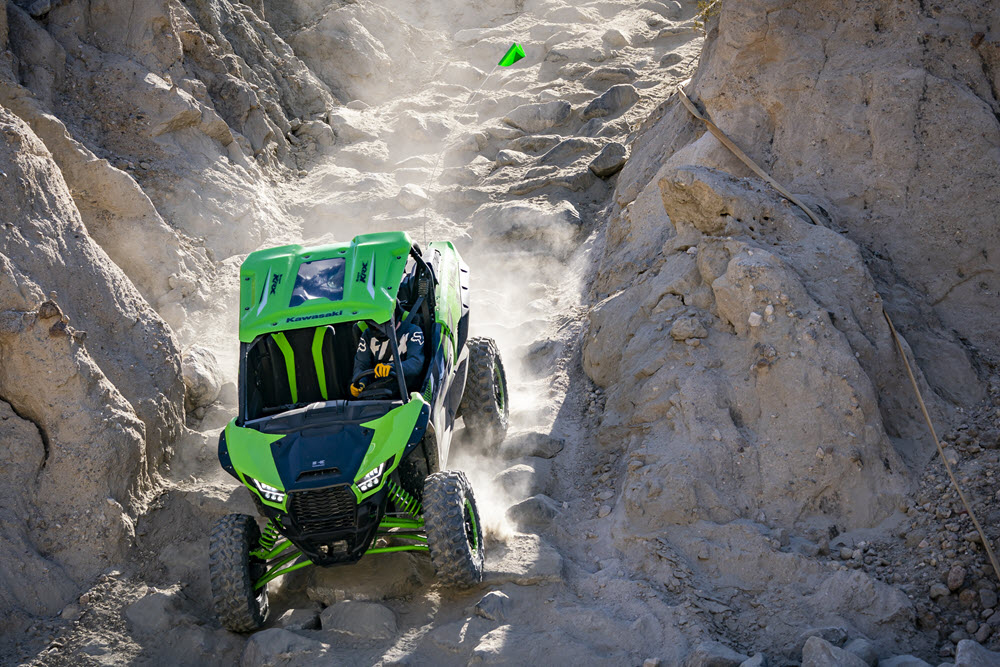
The engine braking on the Teryx KRX 1000 is just about perfect. You can put it in low and take your foot off the brake pedal and it will give you a controlled speed down the hill.
Next up was a loose rock pile that allowed us to put it in low and crawl through the large boulders that put the suspension through a good test, and it felt really good in this terrain. The course also included two rocky uphills that allowed us to test the KRX’s rock-crawling capabilities. The Kawasaki team suggested that we try the low power mode here, and, while we can see where this may be good for a driver with less experience or less throttle control, we preferred to not use it and just stick with low, and, when it gets gnarly, use the differential lock. The throttle control and clutch engagement are plenty good to not need the reduced power, and you sometimes need more power to keep your momentum. For steep downhills, especially one relatively long rocky one on the course, the engine braking worked amazing. You can let off the brakes and let the engine hold it back at a controlled speed. These rock-crawling sections are where the KRX 1000 really shined.
The loops included some open washes with some twisty turns and a few small drop-offs, and the KRX 1000 felt very predictable at speed. Because we had several vehicles following the same loops, both became pretty rutted two-tracks and the KRX felt stable hitting these. It does feel like it has a bit of body roll when you really push it into corners, despite having anti-sway bars on both the front and back.
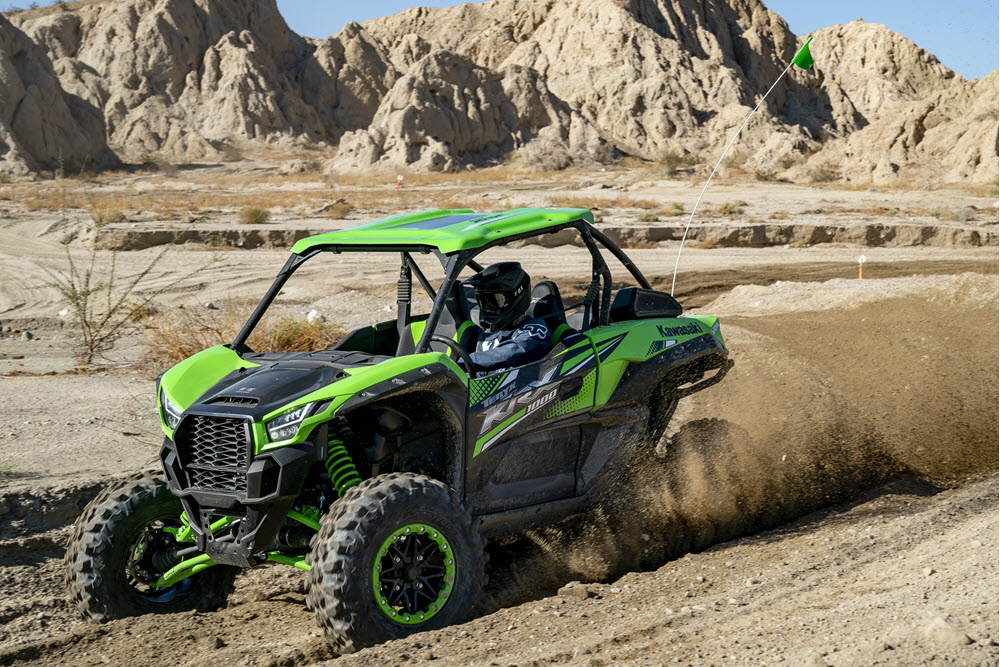
Our first driving impression of the 2020 Kawasaki Teryx KRX 1000 leads us to believe it will become a popular choice for sport UTV enthusiasts.
Overall, the visibility out of the cockpit is okay, but not as good as some other UTV models. The front hood and fenders obscure the view to the ground in slow, technical sections. The seats are reasonably comfortable, and the dash provides all of the critical information. The belt-temperature gauge is great, as knowing this can remind you to back off before burning up a belt.
Two last things to point out are not about driving the KRX, but are a big part of the ownership experience: The KRX 1000 includes a sight glass to check the oil level, and the air filters for both the engine and the CVT are relatively accessible making for easier service work.
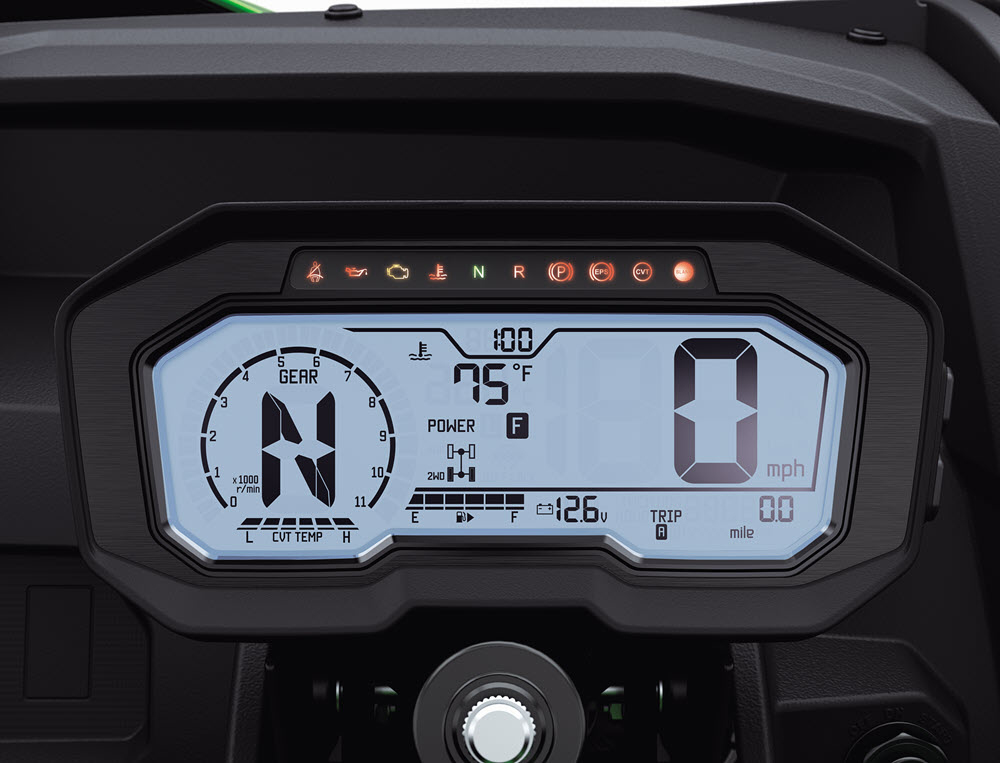
The dash provides all of the necessary information to monitor you ride. We especially liked the CVT temp as that can help warn you to back off before you tear up a belt. We did not get to abuse it much, but never saw that temp rise so it appears to be a solid clutch setup.
How does the Teryx KRX 1000 compare to the competition?
As we noted earlier, it is not really fair to try to compare vehicles driven on different days in different conditions. That being said, we can say that the Kawasaki Teryx KRX 1000 is going to be a viable option to a lot of the established sport UTV models. Based on the specs, price point and performance, we feel that the primary competitive models are the Polaris RZR XP 1000, Can-Am Maverick X3, Honda Talon 1000R and 1000X, and the Yamaha YXZ1000R. We summarized the specs for these models in the chart below:
| Width | Wheelbase | Front Suspension Travel | Rear Suspension Travel | Drivetrain | Engine | Claimed Horsepower | |
| Kawasaki Teryx KRX1000 | 68.1 Inches | 98.8 Inches | 18.6 Inches | 21.1 Inches | CVT Belt Drive | 999cc Twin Cylinder | 112 |
| Polaris RZR XP 1000 | 64.0 Inches | 90.0 Inches | 16.0 Inches | 18.0 Inches | CVT Belt Drive | 999cc Twin Cylinder | 110 |
| Can-Am Maverick X3 | 64.0 Inches | 102 Inches | 20.0 Inches | 20.0 Inches | CVT Belt Drive | 900cc Three Cylinder Turbo | 120 |
| Honda Talon 1000R | 68.4 Inches | 92.7 Inches | 17.7 Inches | 20.1 Inches | 6-Speed Automatic DCT with Manual Option | 999cc Twin Cylinder | 105 |
| Honda Talon 1000X | 64.0 Inches | 87.6 Inches | 14.6 Inches | 15.1 Inches | 6-Speed Automatic DCT with Manual Option | 999cc Twin Cylinder | 105 |
| Yamaha YXZ1000R | 64.0 Inches | 90.5 Inches | 16.2 Inches | 17.0 Inches | 5-Speed Manual with Foot Clutch | 998cc Three Cylinder | NA |
| MSRP | Claimed Weight | Turning Radius | Fuel Capacity | Ground Clearance | Tire Size | Wheel Diameter | |
| Kawasaki Teryx KRX1000 | $20,499.00 | 1896 lbs | 19.4 ft | 10.6 gal | 14.4 Inches | 31 Inches | 15 Inches |
| Polaris RZR XP 1000 | $18,599.00 | 1448 lbs | 17.9 ft | 9.4 gal | 14.0 Inches | 29 Inches | 14 Inches |
| Can-Am Maverick X3 | $18,999.00 | 1481 lbs (“dry”) | NA | 10.5 gal | 14.0 Inches | 28 Inches | 14 Inches |
| Honda Talon 1000R | $20,999.00 | 1545 lbs (“wet”) | 21.3 ft | 7.3 gal | 13.0 Inches | 28 Inches | 15 Inches |
| Honda Talon 1000X | $19,999.00 | 1490 lbs (“wet”) | 17.7 ft | 7.3 gal | 12.7 Inches | 28 Inches | 15 Inches |
| Yamaha YXZ1000R | $18,999.00 | 1521 lbs (“wet”) | 19.7 ft | 9 .0 gal | 13.2 Inches | 29 Inches | 14 Inches |
Aftermarket accessory options for the Kawasaki Teryx KRX 1000
Kawasaki has worked hard to develop an extensive list of genuine Kawasaki accessories, including some full packages for various needs. You will find everything such as: audio systems, windshields, roof options, six-point harness kits, mirrors, heaters, guards, cargo accessories and winches. These items were designed in conjunction with the vehicle to provide good mounting options.
And speaking of aftermarket accessories, Kawasaki has worked closely with several key aftermarket companies to allow them to develop their own accessories. Kawasaki is not offering a turbo option with the launch of the KXF 1000 but they have worked closely with KT Performance to provide develop an aftermarket turbo option.
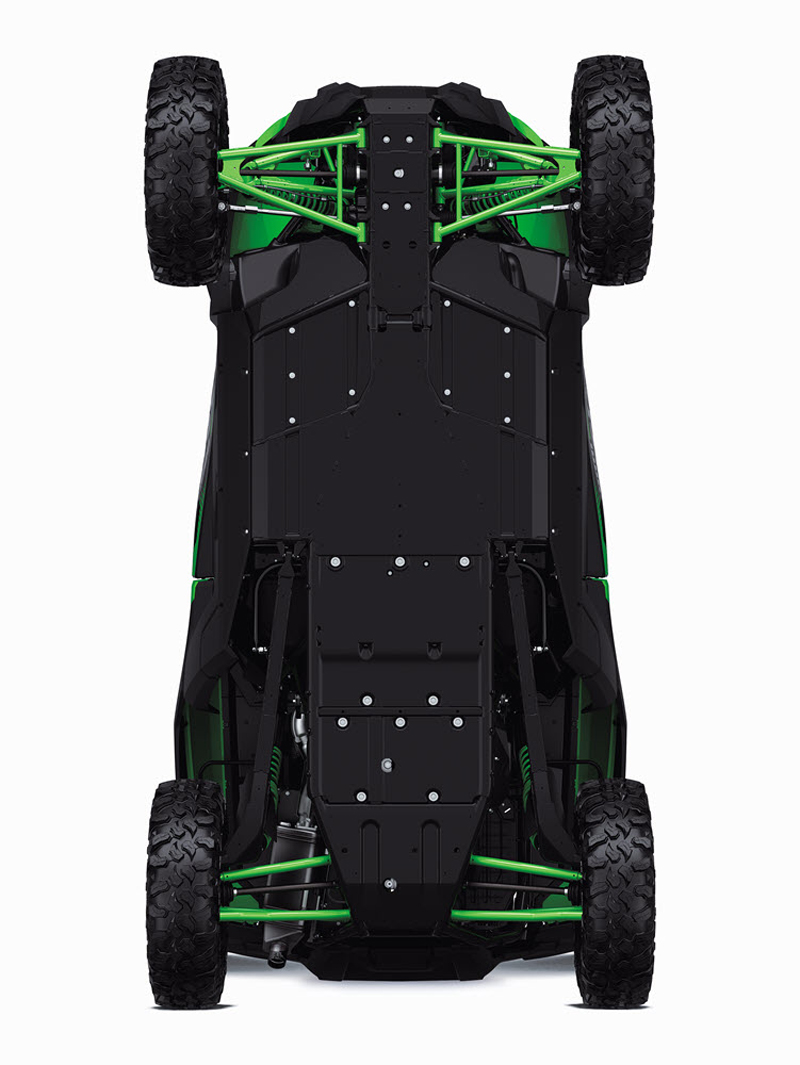
The entire bottom of the Kawasaki Teryx KRX 1000 is covered with skid plates and about 80% of those are steel. This adds to the durability of the KRX 1000 but also likely contributes to it being heavier than all of the competitive models.
Conclusion
It is a great time to be in the market for a new sport UTV, as you can now add Kawasaki to the list of viable options to choose from. While we can’t say that any one feature on the new KRX 1000 sets it apart from the alternative models, it does everything pretty well and appears to be a sturdy build that will hold up to a lot of fun and abuse. The standard 31-inches tires mounted on bead-lock rims, higher ground clearance and sturdy skid plates combined with excellent throttle control and clutch engagement put it near the top in terms of rock-crawling performance. And the engine braking provides a lot of control on steep and technical downhills. Based on our first impressions, we believe the new Kawasaki Teryx KRX 1000 will become a popular choice for Sport UTV enthusiasts.
COMPANY DETAILS |

|
|
Company |
Kawasaki USA |
|
Website |
|
|
Connect |
   
|
|
Contact |
|
|
Phone |
(866) 802-9381 |
|
Address |
P.O. Box 25252 |
|
Santa Ana, CA 92799-5252 |
ABOUT Kawasaki USA®
Kawasaki is a multi-national corporation with more than fifty holdings (manufacturing plants, distributions centers, and marketing and sales headquarters) in most major cities around the world. Business interests include environmental control and energy plant engineering, machinery and robotics, ship building and marine engineering, power plant engineering and steel structures, rolling stock, aerospace, and of course, ATVs, motorcycles, Side x Side vehicles and personal watercraft. Like all companies, Kawasaki began with a dream and grew into the great corporation it is today.
